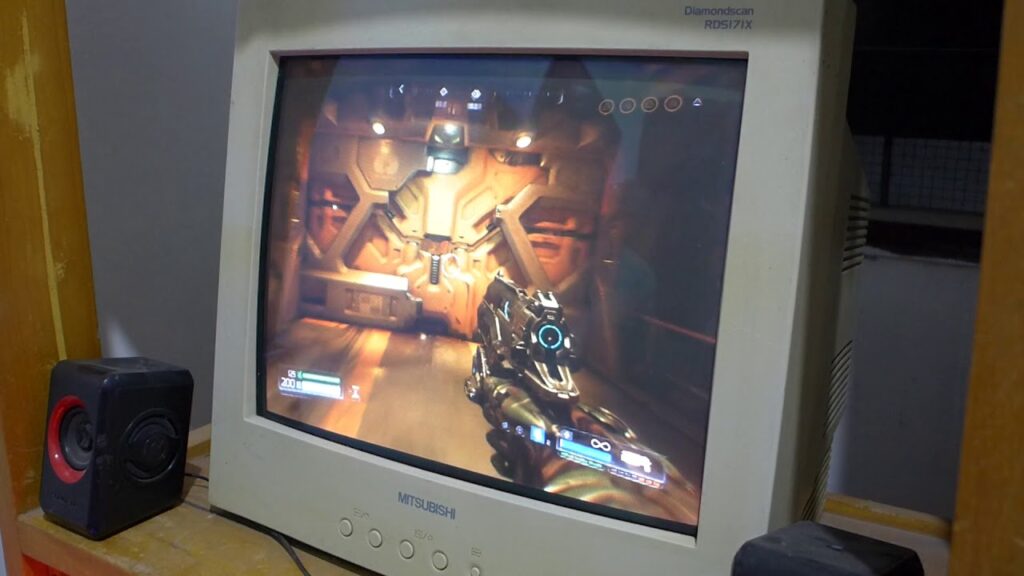There has been a recent increase in interest in the field of high-refresh-rate displays. New monitors have amazing refresh rates ranging from 240Hz to 540Hz. With less screen tearing and more fluid motion, this technological breakthrough represents a significant improvement in visual smoothness and gaming performance. RetroGamingBase on YouTube has recently made significant progress in pushing these limits, producing a refresh rate that significantly exceeds what is currently considered the standard for LCD and OLED displays. RetroGamingBase used an outdated Vision MasterPro512 CRT monitor to achieve an incredible 700Hz refresh rate—a performance that surpasses even the most sophisticated contemporary displays.
Previous to this, RetroGamingBase, a channel known for its dedication to exploring and pushing the limits of retro gaming technology, has obtained notable refresh rates using the Vision MasterPro512. It has already been observed that the CRT display can achieve refresh rates of 255Hz, 300Hz, and even 380Hz, all of which maintain a visually appealing quality suitable for gaming. Despite these remarkable results, the channel still wanted to beat the industry records set by contemporary 540Hz refresh rate displays as the Asus ROG Swift Pro PG248QP and Zowie XL2586X. In addition, RetroGamingBase aimed to exceed the 600Hz refresh rate that a few prototype screens had reached.
To everyone’s surprise, RetroGamingBase not only exceeded the 540Hz and 600Hz thresholds but also achieved a remarkable 700Hz refresh rate. This achievement was made possible by adjusting the Vision MasterPro512’s settings through the custom resolution utility available in the Nvidia Control Panel. Key adjustments included setting a custom resolution of 320 x 120 pixels, configuring the refresh rate to 700Hz, and selecting a progressive scan type with GTF standard timings.
The choice of such a low resolution—320 x 120 pixels—was critical to achieving this high refresh rate. This low resolution was necessary to ensure that the monitor stayed within its kilohertz specification limits, thus preventing instability that could have compromised the refresh rate. Although the resolution is significantly lower than what is common in modern displays, the accomplishment remains impressive and highlights some of the inherent advantages of CRT technology.
Unlike modern LCDs, CRTs do not face the same limitations when it comes to refresh rates. The technology behind CRT monitors allows for much higher refresh rates, provided that one is willing to sacrifice modern resolution standards. This flexibility in refresh rates is coupled with benefits in motion clarity, offering a smoother visual experience without the motion blur issues that are often encountered with LCD screens. CRTs, with their unique technology, can deliver a superior high refresh rate experience, showcasing their capability to push performance boundaries.
However, despite this remarkable technical achievement, CRT monitors are unlikely to be featured prominently in lists of the best gaming monitors today. The bulky design and large footprint of CRTs make them impractical for contemporary gaming setups, especially given the constraints of modern desk spaces. Today’s gaming monitors, with their sleek designs and high resolutions, are more suited to the needs of most gamers, combining advanced features with practicality.
The feat accomplished by RetroGamingBase serves as a fascinating exploration into the capabilities of older technology. It demonstrates that even outdated technology can still offer surprising performance when pushed to its limits. The 700Hz refresh rate achieved on the Vision MasterPro512 CRT is a testament to the enduring potential of CRT monitors, highlighting their unique advantages in terms of refresh rates and motion clarity, despite the technological advancements of modern displays.
The achievement also emphasizes the continued relevance of retro technology enthusiasts who seek to explore and push the boundaries of older devices. While CRT monitors may no longer be a practical choice for modern gaming setups, their capabilities in terms of refresh rates and motion clarity remain impressive and noteworthy. The 700Hz refresh rate on a CRT monitor is a niche achievement, mainly of interest to those who enjoy experimenting with and exploring the limits of older technology.
This accomplishment sheds light on the different ways in which technology evolves and the diverse capabilities that various types of displays can offer. As technology advances, it is intriguing to see how older devices like CRT monitors can still hold their own in certain aspects, even when compared to the cutting-edge consumer gaming monitors of today. While the practical applications of such high refresh rates on CRTs may be limited in contemporary settings, the achievement underscores the remarkable potential of retro technology and the ongoing curiosity of enthusiasts who continue to explore its capabilities.
Even in a world dominated by cutting-edge LCD and OLED displays, older technology can still wow and astonish, as Retro Gaming Base’s Vision MasterPro512 CRT proves. This old monitor’s amazing 700Hz refresh rate demonstrates the special benefits of CRT technology, especially with regard to flexibility in refresh rate and motion clarity. The fact that CRTs can still attain such high refresh rates shows how resilient they are and how excited people are to keep exploring and pushing the boundaries of old technology, even though they may not be suitable for most modern gaming setups.
If you like the article please follow on THE UBJ.
